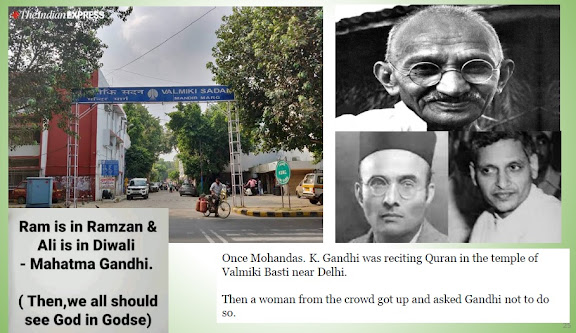Good Action, Bad Action and No Action
Good Action, Bad Action and No Action By S. Sankaran.
You are traveling in a train. The trees seen through the windows of the
train are moving fast depending upon the speed of the train. The train and yourself
in the train are moving, but the trees are fixed to the ground and are static
without any movement by themselves. But, your movement - i.e. action of yours
is being imposed on the trees, which seem to move. This is called ‘inaction in
action’. Inaction of the trees has action imposed on them.
In the sea, a ship, which is moving, seems to be motionless for the man
at the shore. Similarly, moon is moving, but to you, it seems to be motionless.
The movement of ship and moon ends up in inaction for the man who has no
action. Here action is ‘action in inaction’.
What is the purpose of narrating the phenomenon of ‘inaction in action’ and ‘action in
inaction’?
The above narrations are only prelude to explain the intricate
meanings
of one of the important stanzas in the Bhagavad
Gita in Chapter 4 – stanza 18.
The translated version
of the stanza is:
He who sees inaction in action and action in inaction is
enlightened among men. He is a yogi. He has completed all actions.
Here Good or Beneficial Action is called Karma. Bad or Baneful Action is Vikarma. No Action
is called Akarma.
‘Akarma in Karma’ i.e. inaction
in action and ‘Karma in Akarma’ i.e. action in inaction need some critical
examinations.
Characteristic of the soul or atma is no action. No action does not mean
inactivity. Body and mind are carrying out the actions and the soul is the
witness – as non-attached self. Those who do actions non-attached to the fruits
of actions and fully satisfied and free from calculations are deemed to have
done nothing, even though engaged in action. No sins are attached to such
actions. This state is called ‘Akarma’ or no action.
Idleness of ignorant should not be confused with akarma or no action.
Such ignorant person keeps willfully idle and says he had abandoned action and
is restful. As he is so only identifying himself with the body-mind without any
perception of the soul – consciousness, his physical worklessness, whether
forcefully adopted or born of idleness, is not to be treated as no action. Inaction
is not idleness, but surcharged with energy.
One aspect of akarma is that, though the man acts, he does not act. The
other aspect is that, though he does not act at all, he moves the whole world
to action. There is in him an immeasurable power to impel to action. This is
the paradox of akarma. It is filled with a power that is capable of infinite
action. It is like steam which when compressed, does enormous work.
A child does a mistake and its father and mother stop speaking to it. It
will create a terrible effect on the child. Not speaking, giving up action – no
action, is far more effective than any kind of positive action. Silence can
achieve what speaking cannot. This non-action, silence, sitting still,
accomplishes much, releases great power for action. What action cannot achieve,
some person, remaining inactive, accomplishes. The presence of some leaders
will ensure control and discipline in the crowd, even though they will be
silent. Their power of presence is enough to ensure the desired effect and
hence they are actually in the mode of ‘no action’.
Actions have both ethical and metaphysical ramifications. Right or moral
action and the wrong or immoral action falls in the sphere of ethics. What
distinguishes action from inaction is a metaphysical question
Ethical aspect of the action is difficult to define. The rationalist may
equate the ethics of action based on the greatest good of the greatest number,
the example of great men or even conscience. But all the above is open to
scathing criticism, as one cannot arrive at any consensus. As against the
rationalist theories, if we seek the guidance of the religions, the theory of
right conduct as prescribed by the scriptures is at variance amongst
themselves. There are also fundamentalism and impracticality due to change of
time and circumstances, if scriptures are taken literally and as given once for
all. Thus what is right action and what is wrong action is very real.
Metaphysical aspect of action is still more difficult to evaluate. What
is real action and what is true inaction are difficult to determine. Inaction
comes to fruition, when the man mixes his action with knowledge of dedication
and detachment. This can be explained by an example. One man cooks regularly
and this becomes his action. When he becomes expert in his cooking, his action
becomes inaction in the sense that the man does his action effortlessly and
efficiently and he becomes knowledgeable in his action of cooking. This is
called action in inaction i.e. attainment of complete knowledge in action.
Adi Sankarara’s interruptions of actions are worth recalling. According
to Adi Sankara, actions are undertaken to ward off evil and attain good. A cow
will be attracted towards a man with a grass and will run away from a man with
a stick. These are due to its instinct nature. Similarly, even man’s resorting
to action to attain good and ward off evil is natural to him by his instinct.
Man resorts to Karma attracted by its good results, as the cow resorts to
grass. He resorts to it not because of Vedas’s call to him but because of the
urge of his desire. Sankara’s implications are that non-performance of Karma
will not entail evil consequences; no command has been disobeyed here, as there
was no command. Sankara affirms that Vedas are not the commands’ of God and so
are not mandatory. He further confirms that Vedas reveal truths and do not
issue any commands.
There are dolls of animals and birds made of gold. If a child sees the
dolls, the forms of the dolls will attract and the child will not be interested
in the substance i.e. gold. But, a goldsmith will be interested in the
substance i.e. gold rather than the forms.
The goldsmith will only look at the weight of the gold
and not its form in evaluating it. The form is relevant to him only in so far
as it reveals the substance, which is his sole concern. Through all forms the
goldsmith sees only the substance. So through all actions and objects, the enlightened
one sees the substance, the God or Almighty.
Let me end up this article with the quote from
Gandhiji:
Karma becomes relatively akarma when it is undertaken for the service
of others, for the sake of our higher good. We may be said to eat and breathe
with that aim only if we have voluntarily and deliberately dedicated our body
to the service of Shri Krishna. He who lives with the knowledge that his body
is not his, that God makes it dance as He wills, may be said to have realized
God.
All karma does in that spirit is akarma. Anything else, though seemingly
akarma, is in truth karma.




Comments